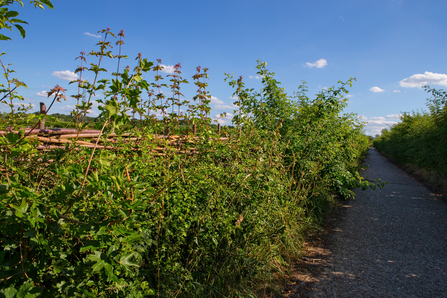Imagine a place where hedgehogs scurry through the undergrowth, dormice leap from branch to branch, beetles munch on decaying wood and birds nibble on ripe berries. This lively scene describes a flourishing hedgerow, the unsung heroes of our landscape.
Helpful hedgerows
Ross Hoddinott/2020VISION

Andrew Parkinson/2020VISION
Despite often being overlooked, these bundles of blackthorn and huddles of hawthorn are active throughout the whole year. During the cooler months, hedgerows are busy cleaning the air and capturing carbon, helping us to fight climate change. Whilst in the warmer months, they provide much needed refuge and an abundance of sumptuous snacks for birds, mammals and insects alike.
On their own, hedgerows house their own busy little ecosystems. But together, they form living corridors connecting our nature reserves, gardens and wild spaces so that wildlife, such as hedgehogs, can sneak across the landscape unseen by predators and access more valuable habitat - vital for nature’s recovery.

Jon Hawkins - Surrey Hills Photography
What are hedgerows made from?
Hedges come in many shapes and sizes, from narrow strings of scraggy hawthorn bushes to thick bushes, tangled with dog rose, bramble and honeysuckle and overtopped with mature trees.
The best hedges for wildlife are thick and broadest at the bottom with a range of woody species such as: field maple, hazel and spindle which provide wildlife the most cover. Ramblers such as bramble and rose are frequent, together with climbing honeysuckle and wild clematis. At the foot of the hedge, thick herbaceous vegetation commonly includes species such as cow parsley and hedge mustard with coarse grasses, although sometimes woodland flora is found with bluebells and greater stitchwort.
How many animals use hedgerows?

Ian Pratt
In total, hedgerows support several hundred species across the UK.
They provide song posts, shelter and nesting opportunities for both woodland and farmland birds such as yellowhammer, whitethroat, blue tit and great tit, while nectar, berries, nuts and leaves provide food for an assortment of invertebrates, mammals and birds.
Keep an eye out near water as, during spring, you might even spot newts and toads feeding on the flurry of invertebrates.
Are hedgerows in decline?
Originally, hedgerows were planted to show ownership boundaries but from the mid-20th century, tens of thousands of hedgerows have been removed as a result of grants aimed at increasing agricultural efficiency. Many remaining hedges have been savagely trimmed, neglected or affected by drifting agricultural chemicals that are sprayed.
Can I make my own hedgerow?
The answer is yes! By planting a hedgerow in your garden, you will be adding a whole new habitat for wildlife to enjoy. Your garden will become part of the hardworking network of hedgerows helping to connect up our patchwork landscape. Creating these corridors will not only help bring wildlife back but it will help it become more resilient in the face of climate change.

